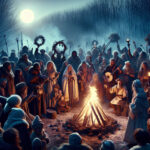The Pagan Lord is a historical novel by Bernard Cornwell which follows the story of Uhtred of Bebbanburg, a Saxon warrior who is forced to choose between his native country and the new religion of the Vikings. In this article, we will explore the themes, plot, and characters of The Pagan Lord, and consider how this thrilling novel captures the complexities of life in Anglo-Saxon England.
The Pagan Lord is a powerful figure in pagan mythology, associated with fertility, protection, and abundance. He is often depicted as a strong, muscular man riding a horse or a bull, and is often associated with thunder and lightning. He is a powerful force, who can bring both good and bad fortune, depending on how he is treated. He is the protector of his people, and if they treat him well, he will bring them good luck and prosperity.
Who is the Pagan Lord?
The Pagan Lord is a central figure in many ancient pagan religions and mythologies. He is often seen as a personification of nature, a powerful being who can bring fertility and abundance to his people. He is sometimes seen as a god of fertility, a protector and provider of his people. He is also seen as a god of war and destruction, a bringer of chaos and destruction.
The Pagan Lord is often associated with thunder and lightning, and is often depicted riding a horse or a bull. He is seen as a powerful force, capable of both good and bad fortune. He is a protector of his people, and if they treat him well, he will bring them good luck and prosperity.
What is the Pagan Lord’s Role in Mythology?
The Pagan Lord is a powerful figure in many ancient pagan mythologies. He is seen as a god of fertility, a protector and provider of his people. He is also seen as a god of war and destruction, a bringer of chaos and destruction. The Pagan Lord is often associated with thunder and lightning, and is often depicted riding a horse or a bull.
In many mythologies, the Pagan Lord is seen as the ruler of the gods, and is responsible for maintaining balance between the different worlds. He is seen as a powerful force, capable of both good and bad fortune. He is a protector of his people, and if they treat him well, he will bring them good luck and prosperity.
In some mythologies, the Pagan Lord is associated with death and resurrection. It is believed that he brings the dead back to life, and he is seen as a powerful force of nature who can bring death and destruction, but also rebirth and renewal.
What is the Pagan Lord’s Role in Modern Paganism?
The Pagan Lord is still an important figure in modern paganism. He is seen as a powerful force of nature, capable of both good and bad fortune. He is a protector of his people, and if they treat him well, he will bring them good luck and prosperity. He is also seen as a god of fertility, a protector and provider of his people.
The Pagan Lord is often invoked in rituals and spells, and is seen as a powerful ally who can bring good fortune and success. Many modern pagans honor and celebrate the Pagan Lord in their rituals and ceremonies. He is seen as a powerful force of nature, capable of both good and bad fortune.
How Can I Honor the Pagan Lord?
There are many ways to honor and celebrate the Pagan Lord. You can make offerings of food and drink, or create artwork and sculptures in his honor. You can also burn incense and candles, or chant and sing songs in his honor. You can also honor him through meditation and prayer.
Honoring the Pagan Lord is a way to show respect and gratitude for his power and protection. It is also a way to ask for his guidance and blessings. By honoring the Pagan Lord, you can bring good luck, abundance, and protection into your life.
The Pagan Lord is a powerful reminder of the strength of pagan belief and its lasting impact on our culture. It is an example of how the ancient traditions of paganism can still be relevant today, and how they can be used to tell stories that are as compelling as any found in modern literature. The Pagan Lord is a testament to the power of myth and the importance of understanding our history and the beliefs that have shaped our world. It is a reminder that paganism is still alive and flourishing, and that its stories can still be used to create powerful and meaningful works of art.





